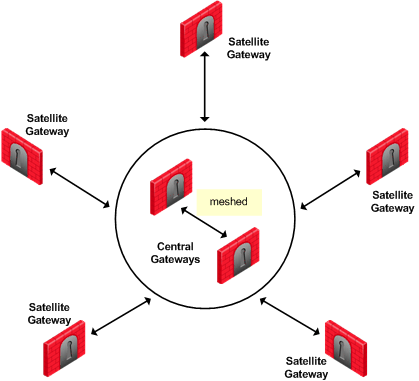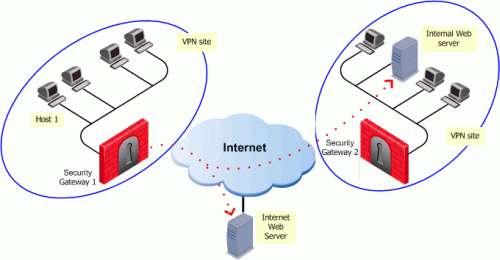VPN Communities
What can I do here?
In this window you can add, edit, and delete VPN communities and change their gateway assignments.

|
Getting Here - SmartConsole > Security Policies > Access Control > Policy > Access Tools > VPN Communities
|
Understanding VPN Communities
VPN Communities
Creating VPN tunnels between Security Gateways is made easier through the configuration of VPN communities. A VPN community is a collection of VPN enabled gateways capable of communicating via VPN tunnels.
To understand VPN Communities, a number of terms need to be defined:
- VPN Community member. Refers to the Security Gateway that resides at one end of a VPN tunnel.
- VPN domain. Refers to the hosts behind the Security Gateway. The VPN domain can be the whole network that lies behind the Security Gateway or just a section of that network. For example a Security Gateway might protect the corporate LAN and the DMZ. Only the corporate LAN needs to be defined as the VPN domain.
- VPN Site. Community member plus VPN domain. A typical VPN site would be the branch office of a bank.
- VPN Community. The collection of VPN tunnels/links and their attributes.
- Domain Based VPN. Routing VPN traffic based on the encryption domain behind each Security Gateway in the community. In a star community, satellite Security Gateways can communicate with each other through center Security Gateways.
- Route Based VPN. Traffic is routed within the VPN community based on the routing information, static or dynamic, configured on the Operating Systems of the Security Gateways.

The methods used for encryption and ensuring data integrity determine the type of tunnel created between the Security Gateways, which in turn is considered a characteristic of that particular VPN community.
A Security Management Server can manage multiple VPN communities, which means communities can be created and organized according to specific needs.
VPN Topologies
The most basic topology consists of two Security Gateways capable of creating a VPN tunnel between them. Security Management Server's support of more complex topologies enables VPN communities to be created according to the particular needs of an organization. Security Management Server supports two main VPN topologies:
Meshed VPN Community
A Mesh is a VPN community in which a VPN site can create a VPN tunnel with any other VPN site in the community:

Star VPN Community
A star is a VPN community consisting of central Security Gateways (or "hubs") and satellite Security Gateways (or "spokes"). In this type of community, a satellite can create a tunnel only with other sites whose Security Gateways are defined as central.

A satellite Security Gateway cannot create a VPN tunnel with a Security Gateway that is also defined as a satellite Security Gateway.
Central Security Gateways can create VPN tunnels with other Central Security Gateways only if the Mesh center Security Gateways option has been selected on the Central Security Gateways page of the Star Community Properties window.
Access Control and VPN Communities
Configuring Security Gateways into a VPN community does not create a de facto access control policy between the Security Gateways. The fact that two Security Gateways belong to the same VPN community does not mean the Security Gateways have access to each other.
The configuration of the Security Gateways into a VPN community means that if these Security Gateways are allowed to communicate via an access control policy, then that communication is encrypted. Access control is configured in the Security Policy Rule Base.
Using the VPN column of the Security Policy Rule Base, it is possible to create access control rules that apply only to members of a VPN community, for example:
Source
|
Destination
|
VPN
|
Services & Applications
|
Action
|
Any
|
Any
|
Community_A
|
HTTP
|
Accept
|
The connection is matched only if all the conditions of the rule are true, that is - it must be an HTTP connection between a source and destination IP address within VPN Community A. If any one of these conditions is not true, the rule is not matched. If all conditions of the rule are met, the rule is matched and the connection allowed.
It is also possible for a rule in the Security Policy Rule Base to be relevant for both VPN communities and host machines not in the community. For example:

The rule in the Security Policy Rule Base allows an HTTP connection between any internal IP with any IP:
Source
|
Destination
|
VPN
|
Services & Applications
|
Action
|
Any_internal_machine
|
Any
|
Any
|
HTTP
|
Accept
|
An HTTP connection between host 1 and the Internal web server behind Security Gateway 2 matches this rule. A connection between the host 1 and the web server on the Internet also matches this rule; however, the connection between host 1 and the internal web server is a connection between members of a VPN community and passes encrypted; the connection between host 1 and the Internet web server passes in the clear.
In both cases, the connection is simply matched to the Security Policy Rule; whether or not the connection is encrypted is dealt with on the VPN level. VPN is another level of security separate from the access control level.
Routing Traffic within a VPN Community
VPN routing provides a way of controlling how VPN traffic is directed. There are two methods for VPN routing:
- Domain Based VPN
- Route Based VPN
VPN Community Options
- > - Create a new Meshed Community. Opens the Meshed Community Properties window.
- > - Create a new Star Community. Opens the Star Community Properties window.
- - Change the selected community. Opens the Community Properties window.
- - Delete the selected community.
Click a listed community to see the gateways that belong to it, and the encryption algorithms used in the VPN communications.


